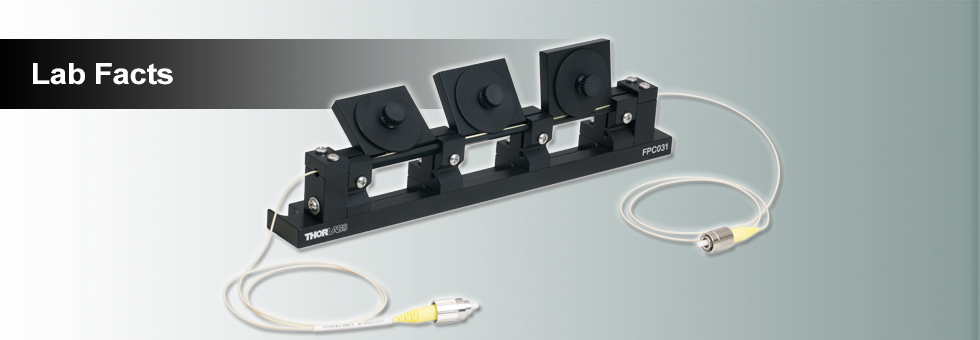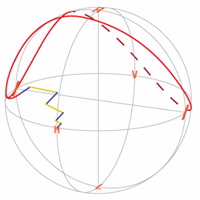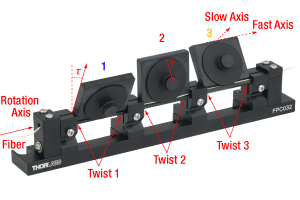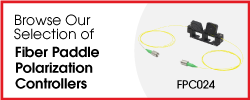Using Fiber Paddles to Manipulate Polarization Lab Facts


Please Wait

Click for Details
Figure 1.2 Poincaré Sphere Showing the Polarization Rotation from a Three Paddle Polarization Controller

Click to Enlarge
Figure 1.1 Forces Produced by the Fiber Controller Paddle
Thorlabs Lab Facts: Using Fiber Paddles to Manipulate Polarization
We present laboratory measurements of the influence on the output polarization state from a fiber due to rotation and twist forces from the fiber polarization controller (FPC). This controller utilizes the effects of stress-induced birefringence to create changes in the polarization of light traveling through a fiber under stress. The stress can be caused either through twisting or rotating [1], as shown in Figure 1.1. It was found that by using the appropriate number of loops on each paddle that the stress-induced birefringence can be adjusted continuously. This then allows for any arbitrary input polarization state to be rotated into any desired output polarization state. We detail the procedures necessary to achieve a desired output polarization, and plot the change in the polarization on a Poincaré sphere to illustrate the steps necessary in reaching a desired polarization state.
For our experiment, we used the previous-generation S1FC1310 Fabry-Perot Benchtop Laser (1310 nm) as the light source and couple it into a Ø900 µm tight-buffer fiber. The fiber was mounted through a FPC030 Fiber Polarization Controller, and the output was collimated into a free-space beam with a fiber collimator. From here the beam was measured, either directly by a polarimeter or through an analyzer assembly consisting of a λ/4 wave plate, a linear polarizer, and a power meter.
Figure 1.2 summarizes the measured results for manipulating the polarization of light in a fiber as a function of rotation and twist forces and is shown on the Poincaré sphere. The colored lines represent one of the three paddles of the FPC030 and correspond to the colored numbers of Figure 1.1. To produce quarter-wave plate behavior, the fiber needed to be looped around a paddle two times, and for half-wave plate behavior it was three times. For the results presented in Figure 1.2, we used the FPC030 FPC in a 2-3-2 loop configuration. As shown in Figure 1.2, starting at any arbitrary polarization state, it is possible to achieve any desired polarization state through rotating each paddle through a number of iterations. This manipulation of the polarization by the FPC does not produce intrinsic loss nor back reflections; instead stress-induced birefringence is utilized as a mechanism for rotating the polarization of light in fiber. Data is presented for each of the paddles of the FPC and the polarization changes due to these are mapped out on Poincaré spheres. For details on the experimental setup employed and the results obtained, please click here.
[1] R. Ulrich, S.C. Rashleigh, and W. Eickhoff, “Bending-induced birefringence in single-mode fibers” Opt. Lett. 5 (1980) 273-275.
[2] R. Ulrich, A. Simon, “Polarization optics of twisted single-mode fibers” Appl. Opt. 18 (1979) 2241-2251.
[3] Collett, E., in Polarized Light in Fiber Optics, (The PolaWave Group, Lincroft, New Jersey, 2002), Chapter 9.
| Posted Comments: | |
| No Comments Posted |
 Products Home
Products Home

 Paddle Polarization Controllers
Paddle Polarization Controllers